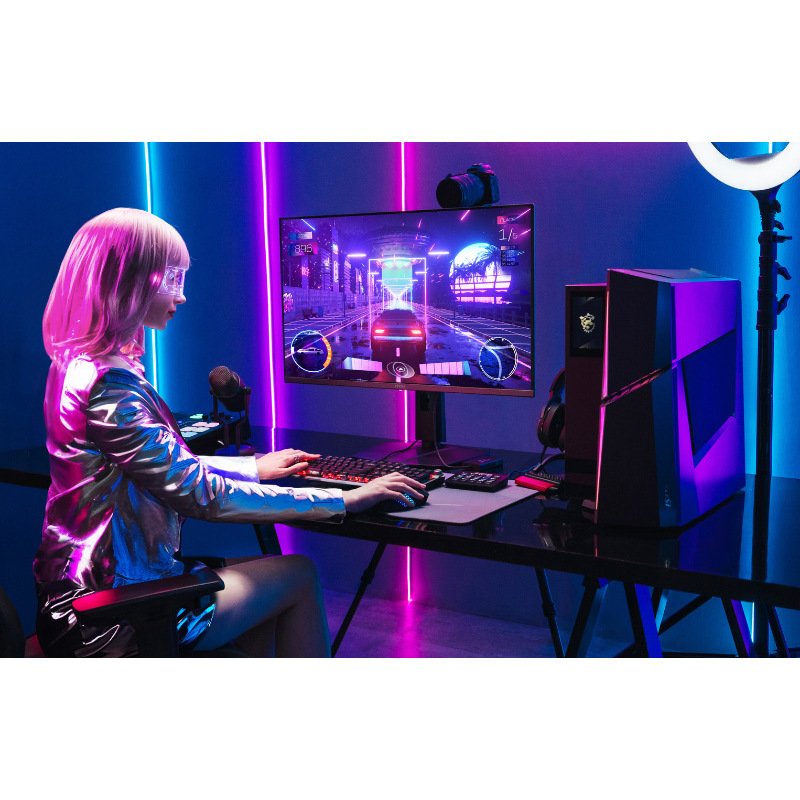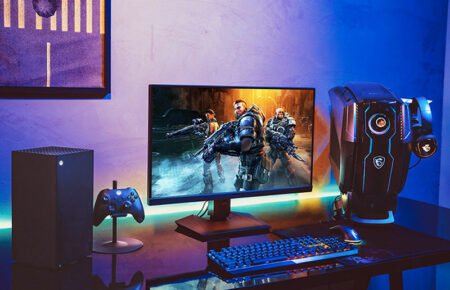CONS
- Subpar image quality versus other IPS displays
- Notable image ghosting during games testing
- Short warranty period
MSI OPTIX MAG274R2 SPECS
| Panel Size (Corner-to-Corner) |
27 inches |
| Native Resolution |
1,920 by 1,080 |
| Aspect Ratio |
16:9 |
What are the functions of a gaming monitor? Primarily, it should excel in gaming performance. However, many consumers desire a monitor that offers not only great gaming capabilities but also high-quality media viewing, all within a reasonable price range. Unfortunately, MSI’s Optix MAG274R2, a 27-inch gaming-oriented panel falls short in both aspects. Our games testing revealed a lackluster and choppy image quality. While its input lag is commendable, the aggressive pricing for a monitor of this size places it at a three-star rating. While it may be a decent option for those on a budget, there are better and more affordable choices available, such as the Dell 27 Curved Gaming Monitor (S2721HGF).
Extremely customizable, internally and externally.
The Optix MAG274R2 boasts a 27-inch screen with a resolution of 1,920 by 1,080 pixels and a maximum refresh rate of 165Hz. Its design is simple and uncomplicated, aligning well with its affordable price point.
The display is supported by an all-black standpost with a flat, rectangular, and robust base. This stand allows for vertical adjustment of over 6 inches, forward and backward tilting from -5 to 20 degrees, and swiveling up to 75 degrees in either direction. The total weight of the assembled unit is 19.2 pounds, with the display portion alone weighing 13.4 pounds, making it suitable for those with a VESA mount designed for lighter loads.
The monitor is propped up by an all-black standpost that culminates in a flat, rectangular, and durable base. This stand enables the screen to be adjusted vertically by slightly over 6 inches, tilted forward and backward within a range of -5 to 20 degrees, and swiveled left and right up to 75 degrees. With a total weight of 19.2 pounds when fully assembled, and the display itself weighing 13.4 pounds, this monitor is a great option for individuals with a VESA mount that can accommodate lighter weights.
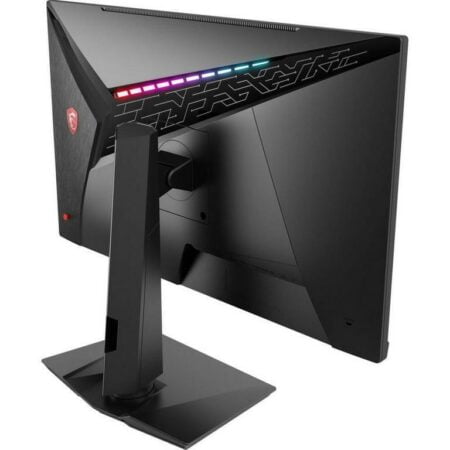
The monitor can also rotate 90 degrees to switch between landscape and portrait mode, a unique feature for a budget-friendly gaming display. In general, the MAG274R2 is a very ergonomic monitor that should easily fit on any desk or wall.

The back of the monitor’s casing features a diagonal strip of lights, each of which is RGB-ready and can be customized. This can be done either through the responsive onscreen display (OSD) menu, which is controlled by a five-way joystick on the back, or by using the MSI Gaming OSD software suite. In order to utilize the software, the display must be connected to your PC via the upstream USB 2.0 port located on the back of the unit.
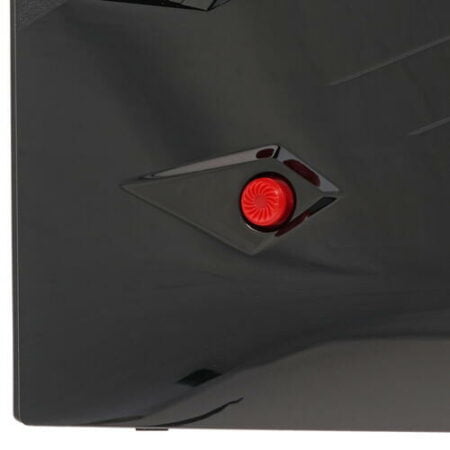
The onboard menu of MSI offers a wide range of customization options and prebuilt profiles to choose from. This includes three distinct gaming modes (RTS, FPS, Racing), along with a Professional mode designed for color work, and a Movie mode optimized for watching content.
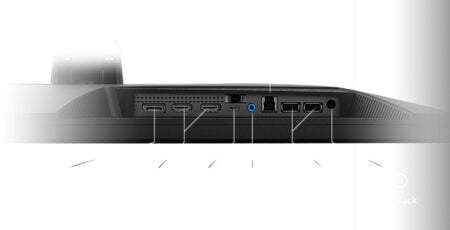
The power button is positioned just below the OSD joystick, whereas the majority of the ports are located towards the back left corner of the monitor. These ports consist of two HDMI 2.0 ports, a DisplayPort 1.4b input, an upstream USB 2.0 Type-B port, two downstream USB 2.0 Type-A ports, a USB-C port (display-ready), a 3.5mm headphone jack for audio passthrough via HDMI, and the power brick connector.
Evaluating the Optix MAG247R2: Not Suitable for Every User.
The 1080p screen is constructed using a typical IPS panel (please take note of the absence of “Fast” or “Rapid” there) with a native refresh rate of 165Hz. Marketed as “HDR-ready,” indicating its capability to receive an HDR signal and convert it to SDR, it is also G-Sync Compatible and supports AMD FreeSync (without the addition of “Premium” or “2” at the end of the latter qualification).
We conducted monitor testing using a Datacolor SpyderX Elite colorimeter, a Murideo SIX-G signal generator, and Portrait Displays’ CalMAN 5 software. Our observations revealed…
In the Standard picture mode using an SDR signal, the MAG274R2 exhibited an unexpectedly high peak brightness measurement of 374.2 nits (despite being rated for only 300 nits), along with a black level of 0.33 nit, resulting in a contrast ratio of 1,150:1, surpassing its specified 1,000:1 ratio. These values remained consistent across other picture modes like FPS, Racing Mode, and Cinema.

Nevertheless, activating the simulated HDR setting had an unexpected outcome, as it actually decreased the nits measure to a mere 223.4. It is important to note that this simulated HDR is not represented in the chart provided. It is advisable to avoid using this mode, as its primary function is more geared towards marketing rather than enhancing the visual experience of your games, movies, or TV shows.
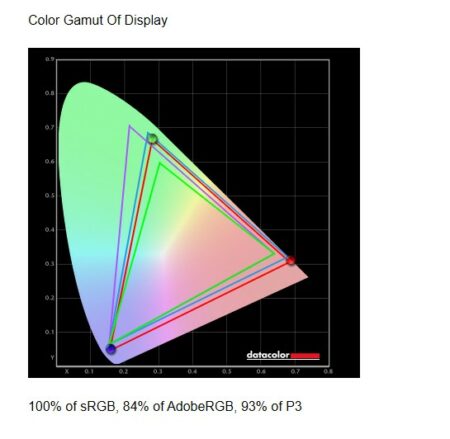
In terms of color performance, the Optix achieved full coverage of the sRGB gamut, and it also excelled in DCI-P3 with a 93% coverage. This makes it a reliable choice for both gamers and those who appreciate vibrant colors. Additionally, the monitor displayed above-average results in the AdobeRGB gamut, with 84% coverage. While this is higher than most gaming panels, it may fall short of the expectations of professional content creators seeking their next monitor.
The MSI Optix MAG247R2 once again impressed us with its exceptional performance in color accuracy testing, achieving a mere 0.91 Delta-E rating during our brief evaluation using the factory default settings.
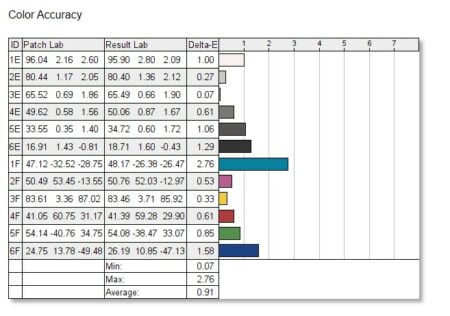
Several gaming monitors are capable of achieving a response time of under 2.0, however, achieving a response time of under 1.0 is considered a remarkable accomplishment. If you are working with color-sensitive materials, conducting a calibration session using the six-axis customization feature under the OSD may potentially reduce this figure even more.
Performance in Media and Gaming.
Moving forward, let’s delve into the media and gaming benchmarks. This is a domain where display technologies such as IPS excel in terms of image quality, yet face challenges due to slower response times, potential ghosting, and artifacts in high-frame-rate situations.
The 4K Costa Rica test footage in HDR, which we downscaled to 1080p to match the monitor’s native resolution, proved to be ineffective. This is because the monitor is not designed for true HDR and the reduced signal quality couldn’t compare to even the simplest HDR400 setups. On the other hand, Red Dead Redemption 2 appeared decent with HDR enabled or disabled, but it didn’t reach the level of excellence that I have grown accustomed to with IPS panels in 2021.
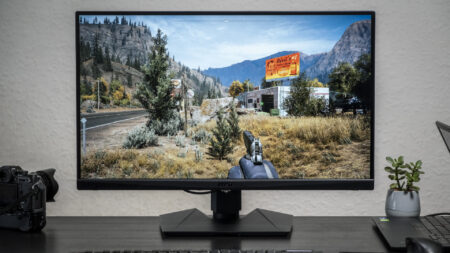
When evaluating the traditional input lag, which is the time delay between a monitor receiving a signal and the screen updating, we utilize an HDFury 4K Diva HDMI matrix. Surprisingly, with a 60Hz test signal, the Optix model surpassed our lag tester, responding so swiftly that the LED diode failed to register a signal. Previously, the quickest model we had assessed was MSI’s ultrawide esports offering, the Optix MPG341CQR, boasting an input lag of 1.4ms. However, upon testing the MAG274R2, our assessment tool displayed an error message stating “Result under 1ms, please check sensor position.”
After conducting the test once more on a different monitor positioned beside the MAG274R2, we observed an anticipated outcome of approximately 5ms. This finding suggests that MSI’s newest Optix model exhibits an input lag of no more than 1ms. Nevertheless, the exact value will remain unknown until our testing technology catches up.
When it comes to gaming performance, I had high hopes for the MAG274R2 with its G-Sync Compatibility and low input-lag. However, I was let down by the noticeable ghosting problems I encountered while playing fast-paced games like Counter-Strike: Global Offensive and Overwatch.
I frequently struggled with the problem of missing crucial whip shots during competitive play, which was detrimental to my performance. Fortunately, I was only playing against bots at the time. However, even with this advantage, the ghosting issue persisted and proved to be a significant problem. Despite the monitor’s impressive gaming display capabilities in terms of input lag, it ultimately falls short. Depending on it to assist you in climbing ranked online ladders may lead to your defeat.
Judgment: Banish Your Spirits.
The Optix MAG274R2 offers a competitive price point for those looking to enter the IPS gaming market, boasting minimal input lag and a wide range of features for its cost. However, the noticeable ghosting during high-frame-rate gaming poses a challenge for serious gamers on a budget. For individuals focused on esports gaming, it is advisable to steer clear of the MAG274R2 due to the substantial ghosting problems that could hinder gameplay rather than enhance it.
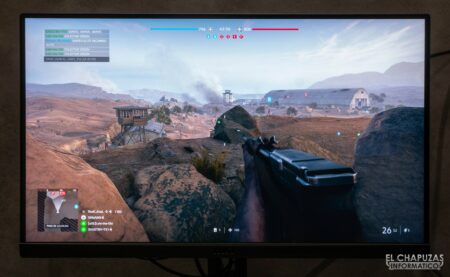
Nevertheless, if you are searching for an IPS panel equipped with HDR-lite that is satisfactory for enjoying movies or engaging in AAA games at 60fps, the MAG274R2 is acceptable. However, its restricted HDR integration results in a lackluster and faded visual experience when the feature is enabled, and the content appears dull when it is disabled. If an IPS panel fails to deliver impressive visuals while maintaining speed, it begs the question of why one would opt for it in the first place.
If you prioritize visual quality and speed, consider investing in a slightly more expensive IPS panel with Nano, Rapid, or Fast IPS displays, such as the MSI Optix MAG274QRF-QD. These options do not compromise on performance. Alternatively, opt for a TN or VA panel that can keep up with fast-paced games like Counter-Strike or Valorant. While the image quality may not be as impressive, you can still achieve a clean shot every time without any ghosting from previous frames.

